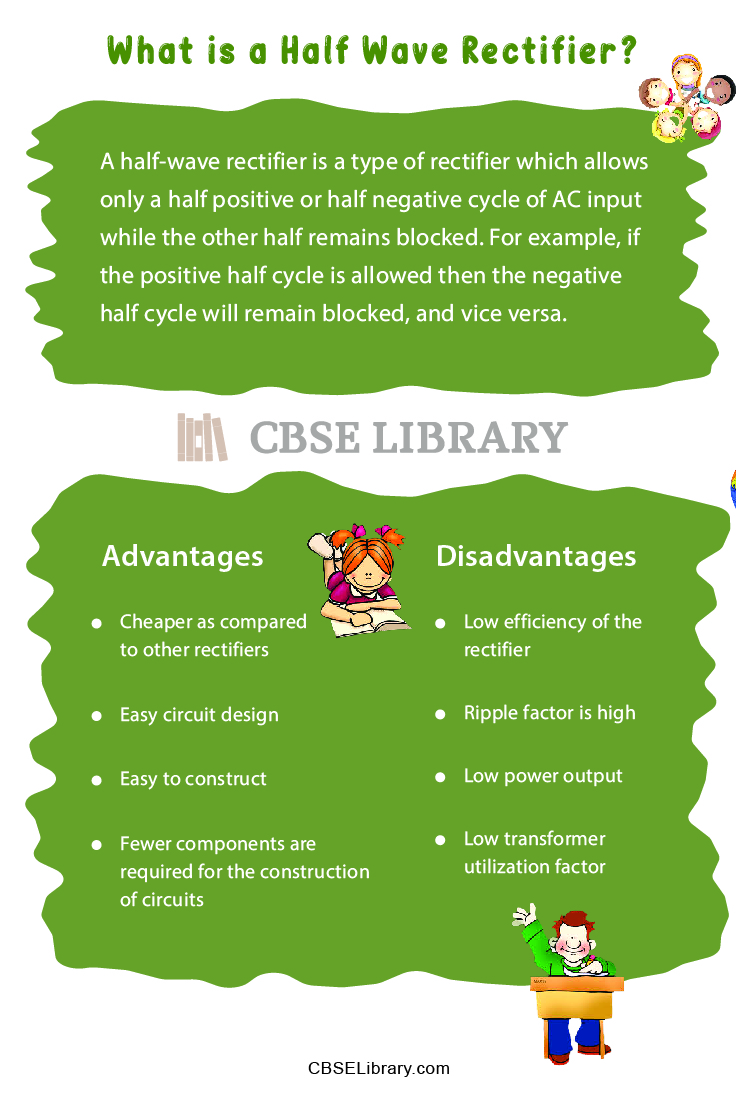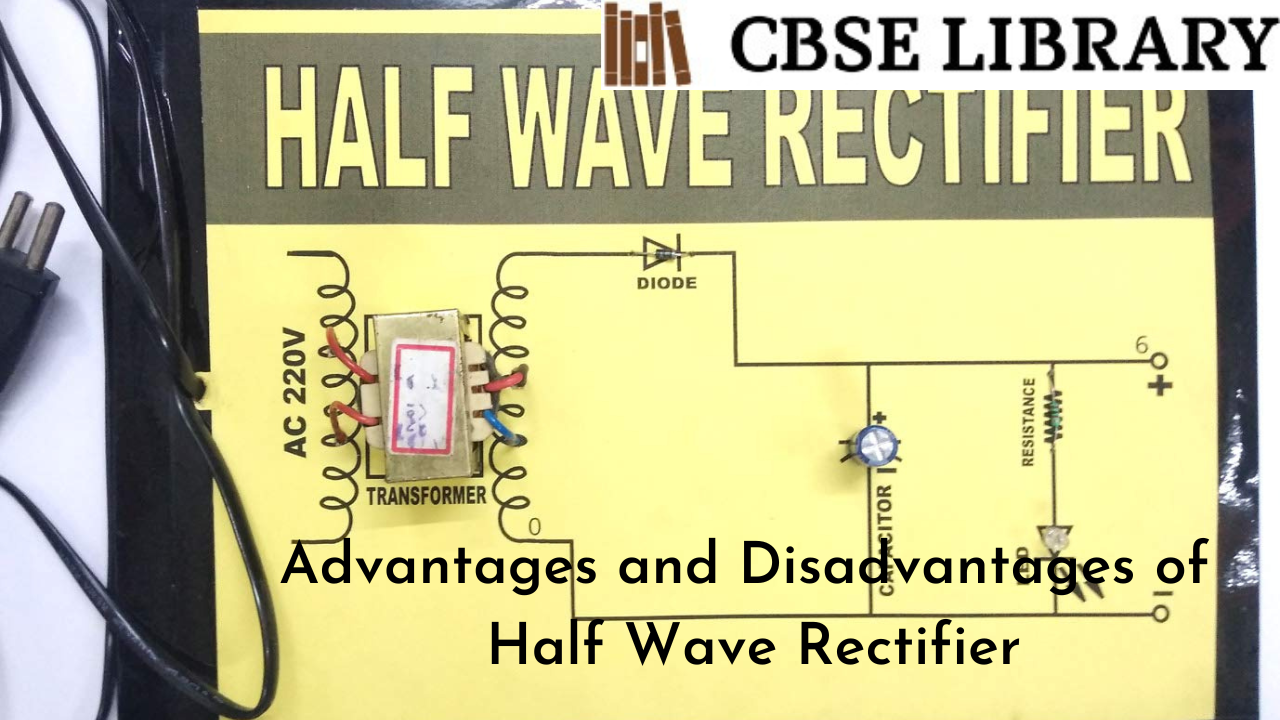Advantages and disadvantages of Half Wave Rectifier 2022: We use so many electronic items that run on different concepts of physics. One such concept is the Half Wave Rectifier. It started in the 1880s when people recognized how unique a rectifier is. Also with the advancement of vacuum diodes into mercury arc tubes also known as rectifier tubes. A rectifier is a diode or a group of diodes that convert AC (Alternate Current) to DC( Direct Current). This diode allows the electric current to pass through it following one direction and blocks the electric current in another direction. Based on the arrangement of diodes in a circuit there are two types of rectifiers. They are Half-Wave rectifiers and Full Wave rectifiers. Now let us see what a Half-wave Rectifier is.
Students can also find more Advantages and Disadvantages articles on events, persons, sports, technology, and many more.
What is a Half Wave Rectifier? Advantages and disadvantages of Half Wave Rectifier 2022
A half-wave rectifier is a type of rectifier which allows only a half positive or half negative cycle of AC input while the other half remains blocked. For example, if the positive half cycle is allowed then the negative half cycle will remain blocked, and vice versa. But both cycles won’t be allowed unanimously. It is the simplest form of the rectifier as only a single diode is used for the construction of a half-wave rectifier. There are three main parts of a Half wave rectifier. They are:
- A Transformer
- A resistive load
- A diode
The diode is between the transformer and the resistor. Unlike a full Wave Rectifier, which makes a complete cycle of alternative voltage to direct voltage. In full-wave rectification, the current flows through the load to the whole circuit in one direction of the input AC supply. Now let us see the advantages and disadvantages of the Half Wave rectifier.
- Advantages of Half Wave Rectifier
- Disadvantages of Half Wave Rectifier
- Comparison Table for Advantages and Disadvantages of Half Wave Rectifier
- FAQs on Pros and Cons of Half Wave rectifier
Advantages of Half Wave Rectifier
Listed are a few advantages of the Half Wave Rectifier.
- Cheaper as compared to other rectifiers: As the number of components required to make the circuit of the Half Wave Rectifier therefore it is cheaper than other forms of the rectifier.
- Easy circuit design: The circuit design consists of a transformer, load, and diode. With a very simple component, the circuit design also becomes simple. Also, it has a straightforward design.
- Easy to construct: The construction of the circuit and its arrangement are very easy. Even an unskilled person with a proper map can construct it.
- Fewer components are required for the construction of circuits: The number of components required is few numbers, as well as simple design, which makes it unique as compared to other forms of the circuit.
Disadvantages of Half Wave Rectifier
Let us briefly discuss the disadvantages of the Half Wave Rectifier.
- Low efficiency of the rectifier: The rectifier efficiency is quite low I.e. 40.5% only which makes it a low efficient half-wave rectifier. The full-wave rectifier is more efficient compared to the half-wave rectifier.
- Ripple factor is high: when a nonlinear device like a capacitor input rectifier consumes the pulse current then it is said to be a Ripple factor. The Ripple factor of a half-wave rectifier is about 1.21 which is very high.
- Low power output: Since there is no output produced during the negative half cycle that is the reason half of the power is wasted. The output amplitude is less than the negative amplitude. Therefore the output is half of the AC voltage source.
- Elaborated filter required for DC output: The filter allows passing the dc component of the load and also blocks the ac component of the rectifier output. In this way, the half-wave rectifier can use the filter for Dc output.
- Low transformer utilization factor: The ratio of availability of DC power at load resistor to the AC rating of the Secondary coil of a transformer is defined as a transformer utilization factor or TUF. In a half-wave rectifier, the TUF is low as .287 or .30 while in a full-wave wave rectifier it is 52% to 81%.
- The average output voltage obtained is less: Since the diode doesn’t turn till the source voltage is above 0.7V because of the potential barrier therefore the output voltage is lower than the peak source voltage and the overall average output voltage obtained is less.
- Not good at the audio system: The pulsating output of the rectifier is not suitable for the electronic devices therefore it is not good for the audio system.
- Wave produced is not DC: The DC produced in Half Wave Rectifier is not pure DC but a pulsating DC. Therefore there is always the chance of ripples.
- DC Output is less: The flow of current is nil to the load therefore there is no or zero voltage produced. Firstly the pulsating DC produced maximizes and then decreases to zero. In this way, DC output becomes less.

Comparison Table for Advantages and Disadvantages of Half Wave Rectifier
Below is the table showing a comparison between the advantages and disadvantages of the Half Wave Rectifier
| Advantages of Half Wave Rectifier | Disadvantages of Half Wave Rectifier |
| Cheaper as compared to another rectifier | Low efficiency of the rectifier |
| Easy circuit design | Ripple factor is high |
| Easy to construct | Low power output |
| Fewer components are required for the construction of circuits | Elaborated filter required for DC output |
| – | Low transformer utilization factor |
| – | The average output voltage obtained is less |
| – | Not good at the audio system |
| – | Wave produced is not DC |
| – | DC Output is less |
From the above table of advantages and disadvantages of half-wave rectifiers, it is clear that half-wave rectifiers have more disadvantages than advantages.
FAQs on Pros and Cons of Half Wave rectifier
Question 1.
What are the uses of Half Wave Rectifiers?
Answer:
Half wave rectifier is used in mosquito repellant, electric welding, various modulations, etc.
Question 2.
What are AC and DC?
Answer:
The electric current flows in two ways as Alternating current (AC) and Direct current(DC). In AC the current keeps on switching directions forward and backward but in DC in a single direction.
Question 3.
What is the advantage of a rectifier?
Answer:
A rectifier is basically used to convert alternating current to direct current.
Question 4.
What is the efficiency of a half-wave rectifier?
Answer:
The highest efficiency of half-wave rectifier is about 40.5%.
Question 5.
What are the advantages of bridge rectifier over half wave rectifier?
Answer:
Bridge rectifier is more efficient than half wave rectifier hence a smooth output is obtained through bridge rectifier as compared to half wave rectifier.
